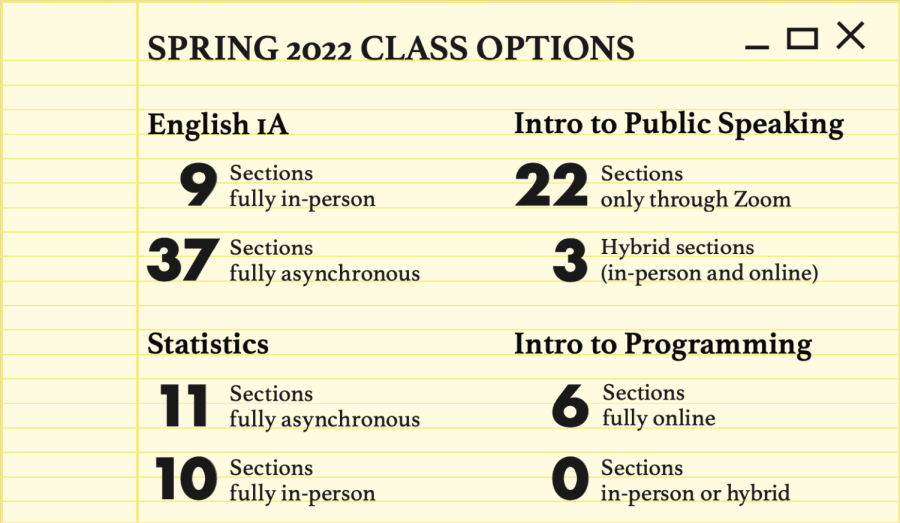As mask mandates fall and in-person gathering restrictions lift, the coronavirus pandemic might feel like it’s ending, but it’s not fully behind us — and it may never completely be. While many aspects of pandemic life are slowly disappearing, one isn’t going anywhere: online learning options.
The pandemic forced Santa Rosa Junior College faculty, staff and students to tackle the online format, which the community now recognizes offers a more effective future for higher education, particularly at the community college level.
“Since March 2020, online learning has been indispensable to preserving continuity in education,” said communication studies instructor Hal Sanford. “There was no better alternative. No reasonable person believed shutting down education or just ignoring the pandemic were better options. We evolved.”
That evolution began immediately in March 2020 when SRJC President Dr. Frank Chong announced the closure of the campus as COVID-19 infections began to ramp up. Classes went entirely online until Fall 2021, when faculty could choose if they wanted to teach in-person.
At the onset of the pandemic, Sanford hadn’t taught a single class online, but as of the end of Spring 2022 — two years later — he has hosted 36 online sections and settled on a successful formula.
“My adjustment to online has eased with each semester. I am sensitive to the different dynamic between Zoom classes and in-person,” Sanford said. “I try to maintain high energy and a focused-but-informal demeanor. Keeping it loose and fun helps students stay engaged, Zoom or in-person.”
It has all been part of the process as instructors figure out what works best for them and their students.
One course that has seen significant adjustment from the beginning of the pandemic is COMM 1, Intro to Public Speaking, a California State University System transfer requirement. SRJC students can choose a variety of learning formats.
Some COMM 1 classes offer Zoom meetings with assigned speeches given live, but others allow students to record their speeches and submit them separately, without having to speak to a group in person. The communication studies department offered three COMM 1 classes in Spring 2022 in a hybrid format, with one in-person meeting per week and speeches performed both in-person and on Zoom.
While it may seem strange to conduct speech classes through the internet, the pandemic catalyzed a greater need for online communication.
“I think that a benefit for students in online or hybrid public speaking courses [is] getting more direct feedback about how to present through remote technology, and for web-based content, which we [as a department] didn’t really focus on before,” communications instructor AC Panella said.
In a September 2021 Gallup poll of 4,034 randomly selected U.S. adults, two-thirds of white-collar employees reported working either fully or partially remote, a number that has hardly wavered even as vaccination rates have increased.
“Now that more occupations are open to remote and hybrid work, students will need communication skills that span across face-to-face, hybrid and remote contexts,” Panella said. “The communication department will work to ensure students get both the material and the type of classes they need to be successful.”
Sanford echoed those thoughts.
“Online [education] provides students with training and experience in the future’s ever-expanding digital workplace,” Sanford said. “Learning how to successfully appear on Zoom is an important part of many jobs.”
In other fields, face-to-face interaction may not be necessary at all. SRJC’s computer studies department does not have a single in-person offering for its more than 40 different classes in the Spring 2022 semester.
The language departments have also benefited from hybrid options.
“[Some] students were never able to take classes in-person before, and Zoom is what made college accessible to them. We’ve come to realize the benefits of offering different options for our students who have diverse needs,” said English as a Second Language Department Chair Luz Navarrette Garcia.
Students who work long hours, lack consistent transportation, live too far away or experience some combination of these factors now have more ways to participate in college.
That’s not to say hybrid learning is the best fit for every student. Navarrette Garcia sees the other side of the argument too.
“Some students chose not to take Zoom classes at all, or they tried Zoom classes but didn’t like them,” Garcia said. “These students are happy and thankful for the ESL classes we started offering in person this year.”
English instructor Matthew Murray volunteered to teach in-person English classes in both the Fall 2021 and Spring 2022 semesters and has also seen students struggle in a digital classroom.
“In general, my students found online learning to be extremely challenging, especially the ability to remain engaged in the learning experience,” he said.
Of the 47 English 1A sections taught in Spring 2022, 35 were taught online, leaving only one-quarter in person.
“I prefer teaching in-person because I feel the communal aspect of learning is vital,” Murray said. “While I was pleasantly surprised when my classes were able to develop this sense of community online, it felt like it took a longer time to develop than in an in-person setting and in many cases, this sense of community did not ever actually develop.”
This could be due to a number of factors.
“A significant number of students are struggling [after returning in-person], so it seems like the pandemic is making learning challenging in general, whether in-person or online,” Murray said.
Speech instructor Panella also sees the advantage of an in-person class experience.
“A friend reminded me that school is a verb. It is a place we go, it is an action we take,” he said. “There is something unique about sharing a classroom space and learning together and a particular kind of spontaneity.”
Finding the proper balance between online and in-person classes will be key for SRJC — or any higher education institution — moving forward, particularly for faculty who took a liking to the new online format.
“Many English department faculty, at least one-third, have expressed a wish to continue teaching online beyond the Spring 2022 semester,” Murray said. “My impression is that many faculty who had not taught online before the pandemic have, over the last two years, come to appreciate teaching online for a variety of reasons.”
The entire SRJC community — students, instructors, faculty and administrators — has made clear it expects a mix of in-person, exclusively online, and hybrid class options to be available in future semesters.
“Ultimately, student demand determines how prominent it is going forward,” Sanford said. “There is an important place for both online and in-person instruction. Time will tell what that balance is.”




